The first year of my life as an indie developer
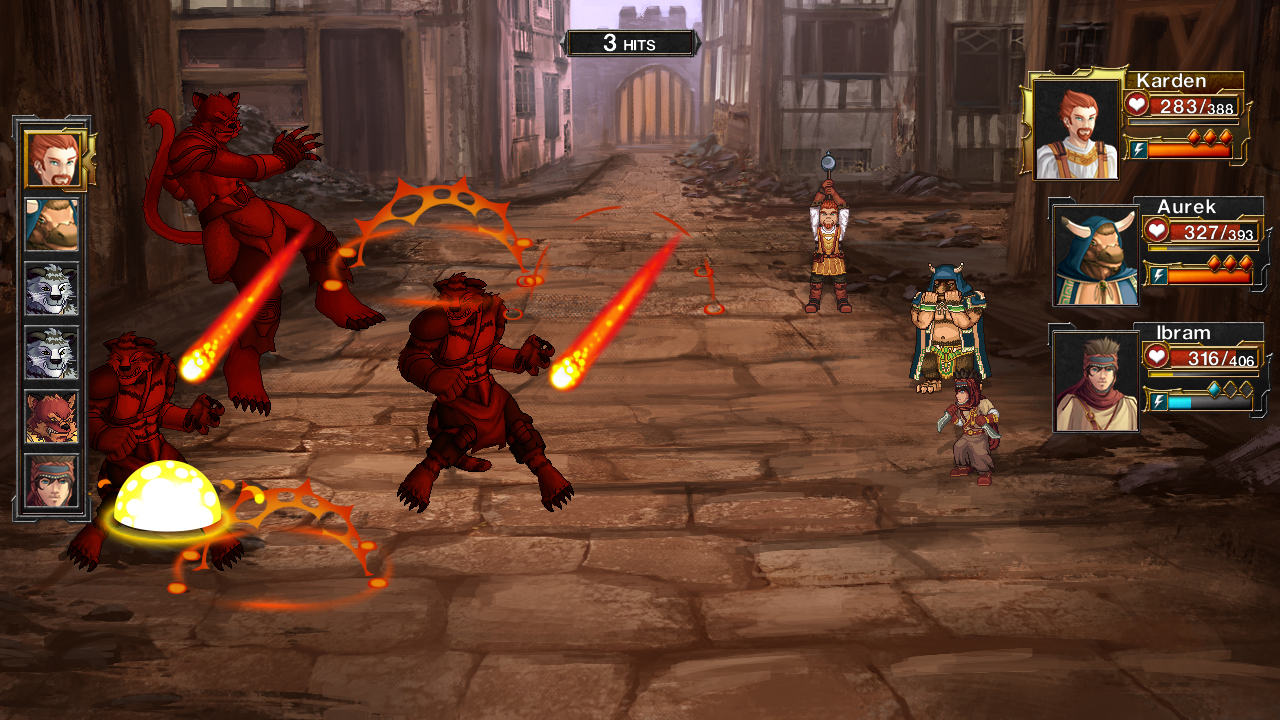
In January 2017, I quit my job as a web application developer in order to fully devote myself to independent game development. This action followed almost five years of developing my first game, when I tried to balance my full-time job and many tasks associated with building an independent gaming company. I want to tell my story of hopes and setbacks a year long.
I am a 35-year-old Canadian who has studied computer science in college and has 13 years of professional experience. I spent most of my life working with web applications, but in the mid-2000s I had been programming Flash games for three years. Before starting work on my first indie game, I never worked as a project manager and never developed games myself.
Most likely, you have already read sad stories about indie developers who released their first games and failed on the market. Unfortunately, my story is just as bleak. While indie masterpieces like Stardew Valley and Undertale were able to create an avalanche of millions of copies sold, for an average game it’s good to sell 1000 copies in the first month.
')
For 2017, I released two games on Steam. The first was JRPG in retro style Arelite Core , released on February 8 after four and a half years of development. I paid over $ 85,000 to hired artists and composer. The game, released only for Windows, has earned less than $ 5,000 in all app stores today.
My second game was the Astral Traveler racing runner created in more than seven months. It took about $ 15,000 for development, spent on a hired 3d-artist and my immediate needs. Including the share of income I shared with the second developer. The game was released on September 13 and since that time has earned less than $ 1,000. Approximately 12% of copies were sold for Mac and 8% for Linux.
In addition, I received about $ 2,000 in donations during Twitch development streams, as well as a handful of generous sponsors at Patreon . Due to this, my total income for 2017 was approximately 7,000 dollars, while the annual expenditures are approximately 13,000 dollars.
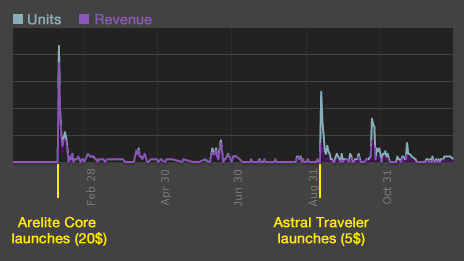
Sales figures are terrible. Fortunately, before getting fired, I was preparing for the worst and saved some money to keep afloat for about a year, regardless of sales volumes. But I won't deny that reimbursement of only 6% of the costs of developing my two released games is much less than what I expected.
To afford such a low income, I lead a rather spartan lifestyle. I have no spouse, no children, no car. I do not smoke, do not drink alcohol and rent a cheap two-room apartment. I limited myself to all the excesses, such as going to theaters and coffee shops. In grocery stores I choose the cheapest brands and, of course, do not buy video games. And since my income is directly related to the release of games, I work 70-80 hours a week.
So, I would like to make an honest review of one of the most difficult years in my life, to explain my mistakes and delusions. I hope so I can help other developers avoid traps. I also want players to better understand what workflow is behind the creation of their favorite games, and what crises and doubts follow.
But before I begin to talk in detail about my first year, I will briefly describe the development of my first game. Do not worry: in this process, too, was full of expensive mistakes, delays and life lessons.
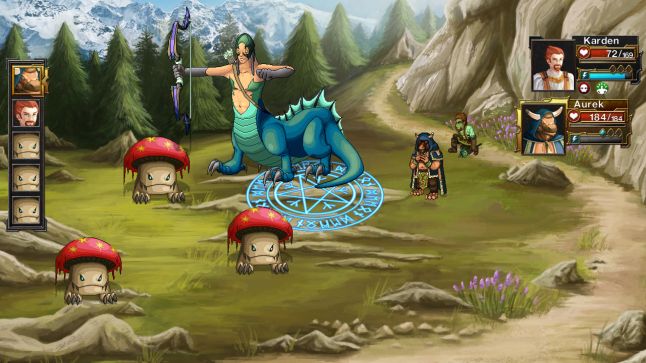
Representations are superior to reality
Arelite Core was released at an inopportune time, followed by a huge number of cheap games created in RPG Maker. Despite my efforts to showcase her unique features, she was always perceived as another junk two-dimensional JRPG, and she was even mistakenly assigned the RPG Maker tag on Steam. I think that because of this note, I lost a lot of potential sales.
In fact, I created my own engine for it, which added another six to twelve months to the development time. But in the end it made a very weak impression on the players who gave the game a quick look. The engine used the Microsoft XNA Framework, which made it compatible with the XBox 360, but the delays in the production process and the discontinuation of support for the framework by Microsoft destroyed these plans.
Nevertheless, my engine was capable of much more than RPG Maker, starting from a highly customizable battle system, which the fighting games inspired me with, and ending with the addition of a greater strategy variability. In addition, I added a crafting system, dynamic encounters with enemies, a unique UI, and even diagonal movements along the stairs, giving the world a sense of depth.
My goal, like that of many novice developers, was to create a large-scale and diverse gameplay with many different locations studied and a wide range of characters and monsters. I wanted to recreate the nostalgic feelings that I had from playing the Final Fantasy series on SNES and at the same time updating the genre so that it would be perceived by the modern audience. Instead of endless monotonous battles, the game increased its duration due to the plot, underlined by cinematic appearance and a unique, memorable soundtrack.
It is because of such ambitious scale development cost 85,000 dollars. This emphasizes one of the most difficult aspects of creating such a game: you have to assume the duties of a producer, because I hired and managed a team of artists who created the graphic resources necessary for the game.
At peak times of game development, I spoke with at least five different groups. My task was to create detailed descriptions and provide reference materials that artists turned into static backgrounds, animation frames for characters and monsters, as well as visual effects. Then I checked each resource and tested it in the game to check if it meets the specified requirements.
For four years, I hired more than twenty artists who worked on various visual elements. The work process included the publication of announcements, a review of dozens of resumes after that, interviews with candidates, the signing of contracts and, of course, permanent management to ensure that the work was done correctly. It was a tremendous task for one person developing games in his spare time from full-time work, who still needed to create his own content.
It is very easy to underestimate the complexity of the work required to manage a team. She made me realize how difficult it is to find reliable employees, even if they are paid for their work. Some of the artists that I hired, engaged in graphics as a hobby, in his spare time, therefore, released content is not permanent. Many of them underestimated their own time frames of production, which forced them to leave the project, that is, they needed to be replaced, and for this to begin the whole process anew.
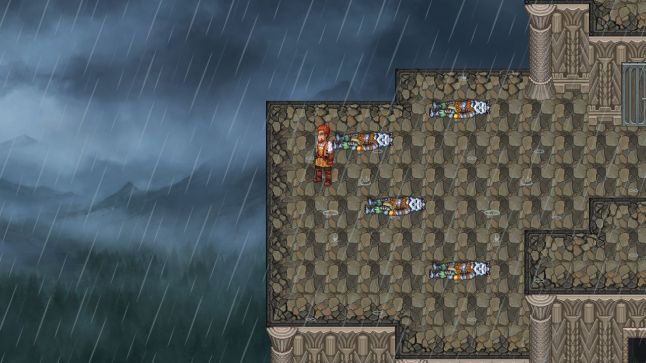
Initially, I wanted to release the game in 2015, but I received the final graphic resources only in mid-2016. I also underestimated my own working time, which I spent on programming the engine, creating levels, design and embedding plot scenes. On each scene could go up to a week. In the process of developing Arelite Core, I had an increasingly heavy burden on my shoulders, because in order to bring the game to a close, I had to give up talking with friends.
Then it was time for PAX East 2016, one of the most serious checks of the reality of the entire project. I was offered a space in the mini-booth department, next to huge indie booths. This gave me the opportunity to get acquainted with many veterans of the industry, which undoubtedly became the most important event of the event.
Nevertheless, the sluggish reaction of visitors and the press has clearly shown that Arelite Core may not come up. People did not criticize the game, but at the same time it was difficult for them to evaluate the retro RPG in the conditions of the exhibition. Anyway, I didn’t feel much enthusiasm, which was necessary for the project to be popular on the game scene. The trip to the event cost 4000 dollars, that is, the costs barely covered all the sales of the game.
After the event, I began streaming the development of Arelite Core on Twitch 12 hours a week. Not wanting to disclose the plot, I showed only the early stages of the game and not very important from the point of view of the plot area. The growth of subscribers on the channel was (and remains) slow, because it was advertised a little in the creative sections of Twitch. Nevertheless, I managed to create a small but strong community around Dragon Slumber, which turned out to be an invaluable gift when I turned into an indie developer. However, for Arelite Core itself it was too late.
Although I expected the failure of my first project, I still hoped for the prospects of the second game. Now that I had more experience, I expected that as the next project I would release a game that could keep myself afloat. Having a full-time job with very little prospects and not getting a promotion in twelve years of work, I decided to put my future on the map and become an independent developer.
I planned my life for several months ahead in order to secure funds for a year, mainly due to accumulations on the account and refusal from excesses. I also started the pre-production stage of my next game, which was helped by the Turkish indie developer Bora Genel. He began to build the foundation of the game in Unity, while I was completing the development of Arelite Core, which was scheduled for release on February 8. The date was chosen because of the relatively small number of issues that week.
Christmas came, the New Year followed, and in January 2017 I quit my job. And this is where the real story begins.

Go to Astral Traveler.
The transition to the development of games with permanent employment was instant. I increased the number of weekly Arelite Core development hours from 40 to 80. This change was critical to complete the development and preparation for the last three weeks before release. To cope with the flow of other games fighting for media attention, I had to hone every aspect and get rid of bugs, write press releases and send assemblies to the press.
It came on February 8 and I released Arelite Core live on stream. It was the culmination of four and a half years of work, but I did not manage to enjoy the moment. My next project was already in development and it took me extra time to get rid of a few more bugs.
The players who tried Arelite Core liked it, but, as expected, the sales figures were disastrous. Almost a year later, the total amount of sales was barely enough to offset the costs of a trip to PAX East. Fortunately, I was ready for such numbers, so they didn’t really affect my fighting spirit and I focused on the next game.
Astral Traveler was a direct answer to the problems from which Arelite Core was suffering. To reduce development costs to a minimum, I planned a short development cycle of 3-4 months and created a design that required a small amount of original resources, focusing instead on the gameplay. Due to cost reduction, the game will be able to support itself with regard to sales volumes. Sharing tasks with my development partner will help make development faster and smoother.
In order to maintain a high level of enthusiasm, competition among players was put in the first place, created using traditional leaderboards and displaying the results of friends during the race. And finally, Astral Traveler should be released at a bargain price of $ 5, capable of luring players even without advertising.
This time I needed to put more effort into advertising, because of the mystery of the development of Arelite Core, the players found it harder to get interested in the project. The whole development process of Astral Traveler was covered from the very beginning through Twitter and my stream development. I joined the CFN community, which helped me to meet a lot of industry professionals. In fact, I spent quite a lot of time improving communications in general.
I made sure that I always had time for a small but faithful community built around Dragon Slumber, which I communicated with through Discord, Twitch, and direct contacts on Twitter. Communicating directly with players and developers has improved the project and expanded our capabilities.
Access to this community helped me get faster feedback, both through comments during the streams, and from direct game testers. I was lucky to receive subscriptions and donations to Twitch, as well as a few subscribers to Patreon, which gave more than 25% of my annual income.
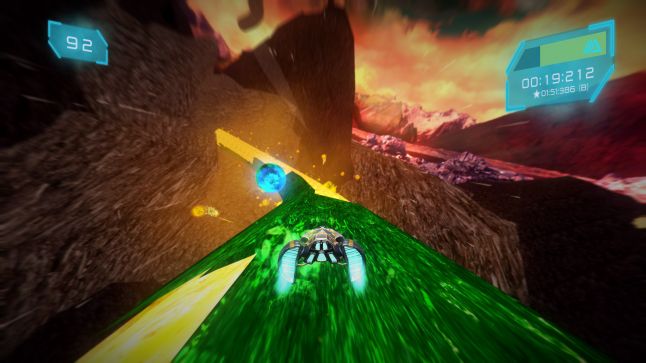
By March, Steam announced the curtailment of the program Greenlight, without specifying specifically how it will look and how much it will cost to replace it. Not wanting to take risks, we quickly prepared a trailer and screenshots based on ready-made resources. As a result, the game turned out to be very different from what we wanted to release, both in terms of graphics and gameplay.
It is natural for a game to evolve during development, but many changes have arisen from necessity. We wanted to give the game an abstract, radiant look, more reminiscent of the organic version of Tron. However, the search for a suitable artist at an affordable price turned out to be a more complicated process than expected, and after several months of research, we decided that Bora would create a visual style and prepare various resources for the five worlds of the game.
We hired a 3D modeler to create a unique look for a ship traveling in space and two enemies. Although the result was amazing, the production process took a little longer and resulted in unexpectedly high costs. At the time of the release of this article, revenues from the game have not yet covered the cost of production.
By the summer, we were already several months behind schedule. Creating the 47 levels of the game required more time than we expected, while Bora was trying to fulfill the additional duties of the lead artist that were unexpected for him. We found that our vision for the design of the game is different. Bora was more interested in the rapid, streaming gameplay, but I liked the complex gameplay, which required a quick reaction of the player. Since the project has already exceeded its budget, we quickly decided to implement my version.
We set the release date for September 13, 2017, seven months after the start of production. Many possible functions of the game were dropped, for example, the version for VR. I was hoping for a mobile version, but due to the fact that we were mainly targeting the PC in graphics and management, it took a significant amount of additional labor. We decided to wait and release the second phase with these functions if the game is successful. Also, in the case of popularity on the PC, we were thinking about releasing on consoles.
As in the case of Arelite Core, I released Astral Traveler on a stream, broadcasting the release to people who were watching the entire development process. Everything was ready for a more successful game, they knew more about us, the game attracted attention and challenged the player just at the time when complex games like Cuphead became popular.
However, it sold much, much worse.
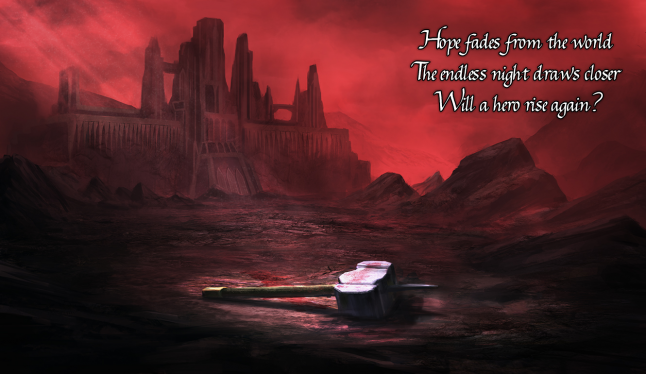
Learning from my mistakes
The failure of Astral Traveler hit me harder than Arelite Core results. For almost a year before the release, I knew that Arelite Core did not “take off”, and although I did not expect Astral Traveler virality, it still seemed to us that its dynamics would be much better.
However, despite all my efforts, its release went almost unnoticed, and I see the reason in several factors. Although Astral Traveler has combined several genres, it could not stand out against other races on the platform. For the average gamer with Steam, its scale was too small, and against the background of the stream of cheap and free games constantly released on Steam Direct, she had no chance.
I spent the next month following the streams of developing Arelite Core: Lleana's Journey, a free add-on that used some of the resources cut from the main game. In addition, there is another piece of the plot and a new difficulty mode. The update brought several sales and a new review, but could not cover the cost of development.
Both of my games suffered from a lack of reviews of people influential in gaming circles. I contacted several popular streamers and YouTube, but received no response. Similarly, a bunch of my requests were ignored by gaming websites with large audiences, which made it difficult for us to communicate with the audience that my games might be interested in.
I decided that my next game should avoid established genres and expected topics. And since I will work on it alone, she must have a minimalistic visual design that I can implement myself. The game should have simple graphics and fresh, somewhat controversial gameplay.
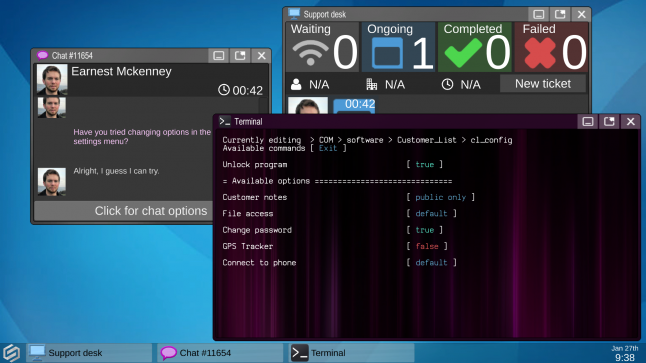
A month after the release of my second game, I began streaming the development of Tech Support: Error Unknown. The game, which has a UI in the style of Windows, allows the player to get used to the role of a technical support specialist who communicates with clients and tries to solve their telephone problems, while also studying corporate compromising and hacktivist groups.
The gameplay consists of communicating with procedurally generated clients in chat windows using different macros to speed up the conversation process. Moving along the plot, the player could get more answers and even hack the system using the terminal’s command line to open up new possibilities.
Compared to my previous games, Tech Support provides more free gameplay. Players can participate in conversations in any way they choose, choose their friends and explore their computers to reveal various subject lines. The game will provide replayability and will encourage repetition with the help of secrets, different story paths and multiple endings.
It will have a procedural structure rather than rigidly defined levels, which speeds up the testing of the balance of the game and facilitates its implementation. The game will have more tools for analyzing the interest and problems of the players. In the future closed alpha version, I will add Unity analytics, as well as a convenient feature for reporting bugs using the Trello API.
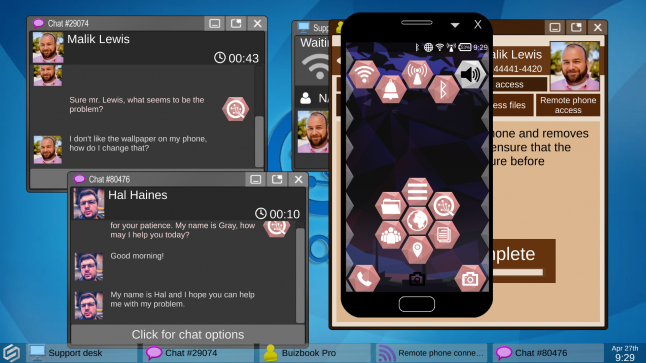
2018 and onwards
2017 has so far been the most difficult year of my professional career. I earned only 20% of my previous salary, released two games that failed as a result, and switched from 30 to 80 hours of weekly game development, without getting much more free time /
Although it’s great not to go out in the freezing Quebec weather, but also have a looser sleep schedule, I still have to work more than 12 hours, seven days a week, actively working on what I hope will be a new hit. I read many articles about the importance of rest and avoiding burnout, but today comfort is not a luxury that I can afford. Doing your business is not like a regular salary job - you won’t get money if you don’t have any sales.
Veterans can not tell me how difficult it is to work in this industry. We are driven by our passion, we are united as developers, but at the same time we are competing with each other for the attention of our audience, both players and influential people. Those who build on the development of their games must be prepared for the harsh reality. Great games are constantly being released and often go unnoticed in the tidal wave of other games.
Nevertheless, as a novice indie developer, I feel in a privileged position. I have the support of my family and friends, including viewers of my streams and people generously giving me donations to Patreon. These sources allowed me to follow my course and became the main source of social interactions. However, I have to admit - it seems to me that I disappointed people with such a bad first year, and in response to this I can only make more efforts in 2018.
Failures are the reality of most start-up projects, as well as the opportunity for learning and growth. Instead of sales, I was able to meet many industry professionals who help me plan my future game, and the release of Arelite Core with Astral Traveler played an important role in this. In addition, I use new opportunities that have appeared, for example, participation on the Brightlocker platform for additional coverage of information about myself and the game.
So get ready, in 2018 my voice will be heard.
If you want to know more about Tech Support , subscribe to my mailing list or add on social networks:
Dragon Slumber
Twitch
Source: https://habr.com/ru/post/352348/
All Articles